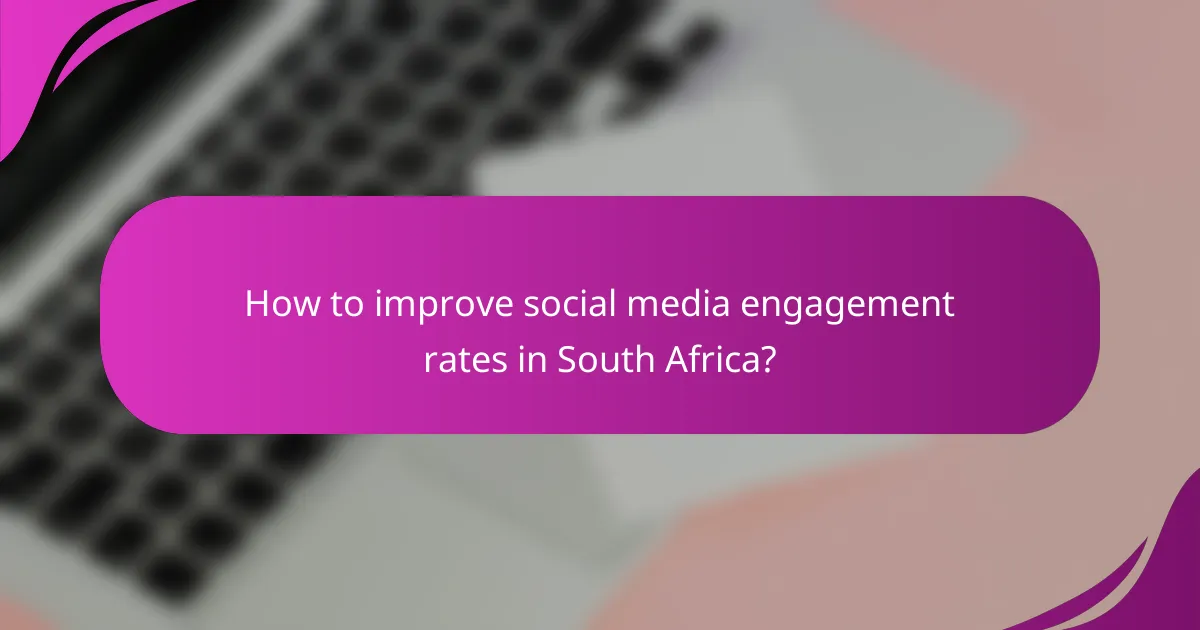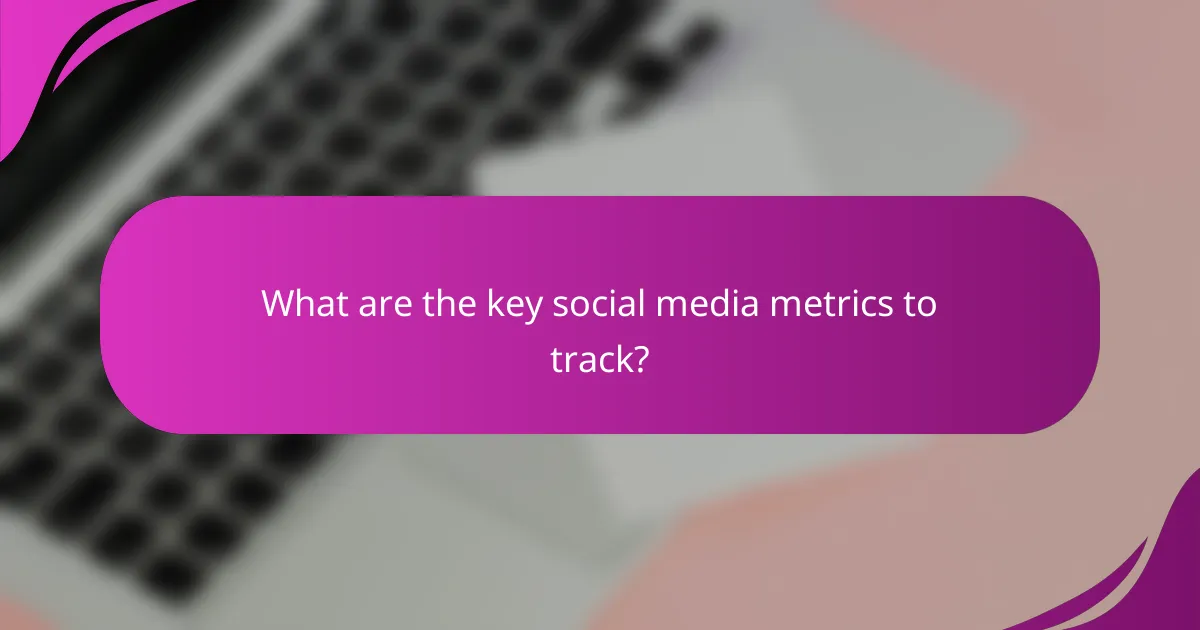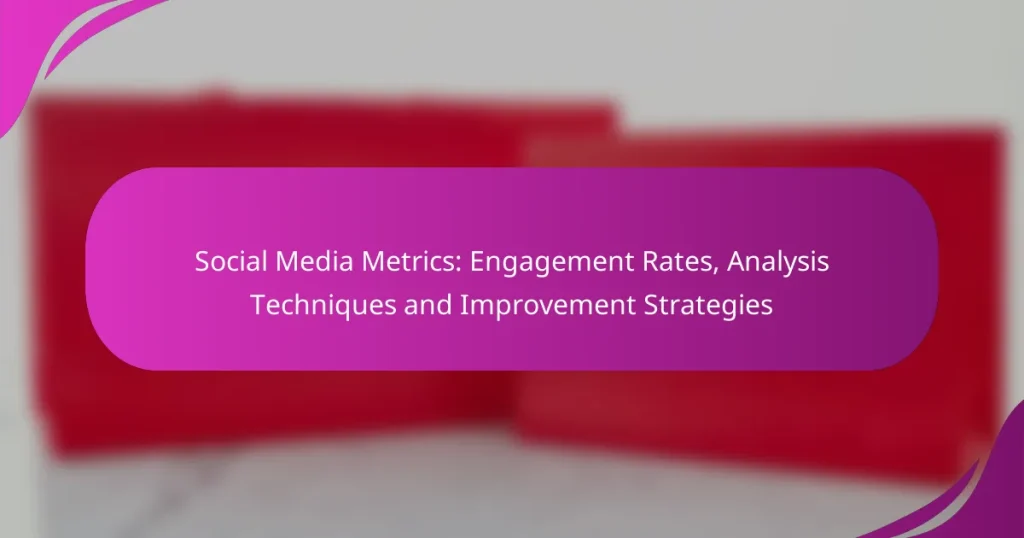Understanding social media metrics is essential for enhancing engagement rates and optimizing content strategies. By focusing on key performance indicators such as engagement rate, reach, and impressions, businesses can gain valuable insights into audience behavior and content effectiveness. Implementing targeted strategies and utilizing analytics tools will further improve interaction and connection with users, ultimately driving better results.

How to improve social media engagement rates in South Africa?
To enhance social media engagement rates in South Africa, focus on creating high-quality content that resonates with your target audience. Implementing effective audience targeting strategies and utilizing analytics tools can also significantly boost interaction and connection with users.
Content quality and relevance
High-quality content that is relevant to your audience is crucial for driving engagement. This includes using eye-catching visuals, informative posts, and engaging storytelling that reflects local culture and interests. Regularly updating your content to align with current trends can keep your audience interested.
Consider using a mix of formats, such as videos, infographics, and polls, to cater to different preferences. Engaging content should encourage discussions, shares, and likes, which are vital for improving overall engagement rates.
Audience targeting strategies
Identifying and understanding your target audience is essential for effective engagement. Use demographic data, interests, and behaviors to tailor your content specifically for South African users. This can involve segmenting your audience based on age, location, and preferences.
Utilize social media advertising tools to reach specific groups more effectively. For example, Facebook and Instagram allow for detailed targeting options that can help you connect with users who are more likely to engage with your content.
Utilizing analytics tools
Analytics tools are vital for measuring engagement rates and understanding user behavior. Platforms like Facebook Insights and Twitter Analytics provide valuable data on post performance, audience demographics, and engagement metrics. Regularly reviewing these insights can inform your content strategy.
Look for patterns in engagement, such as which types of posts receive the most interaction. Adjust your content strategy based on these findings to improve future engagement rates.
Engagement timing optimization
Timing plays a significant role in social media engagement. Analyze when your audience is most active on various platforms and schedule your posts accordingly. Generally, evenings and weekends tend to see higher engagement rates in South Africa.
Experiment with different posting times and track the results to find the optimal schedule for your audience. Tools like Hootsuite or Buffer can help automate posting at the best times for maximum visibility.
Incorporating user-generated content
User-generated content (UGC) can significantly enhance engagement by fostering community and trust. Encourage your followers to share their experiences with your brand and repost their content, giving them recognition. This not only increases engagement but also builds a sense of belonging among your audience.
Consider running contests or campaigns that invite users to create content related to your brand. This can lead to increased interaction and a more vibrant online community, ultimately improving your overall engagement rates.

What are the key social media metrics to track?
Key social media metrics to track include engagement rate, reach and impressions, click-through rate, and conversion rate. These metrics help assess the effectiveness of social media strategies and guide improvements.
Engagement rate
Engagement rate measures the level of interaction users have with your content, typically expressed as a percentage of total followers or impressions. It includes likes, shares, comments, and other forms of interaction, providing insight into how well your audience resonates with your posts.
A high engagement rate often indicates that your content is relevant and appealing to your audience. Aim for engagement rates between 1% and 5% for most platforms, but this can vary depending on the industry and audience size.
To improve engagement, focus on creating high-quality, shareable content and encourage audience interaction through questions or calls to action.
Reach and impressions
Reach refers to the total number of unique users who see your content, while impressions count the total number of times your content is displayed, regardless of whether it was clicked. Understanding both metrics helps evaluate the visibility and potential impact of your posts.
For example, if a post has a reach of 1,000 but 5,000 impressions, it means that some users saw the post multiple times. Aiming for a higher reach can expand your audience, while impressions can indicate how often your content is being shared or re-engaged.
To increase reach, consider using targeted ads, engaging with followers, and optimizing posting times based on when your audience is most active.
Click-through rate
Click-through rate (CTR) measures the percentage of users who click on a link in your post compared to the total number of users who viewed it. A higher CTR indicates that your content is compelling and encourages users to take action.
Typical CTRs can range from 1% to 3%, depending on the platform and industry. To boost CTR, use clear and enticing calls to action, and ensure that your links lead to valuable content that meets user expectations.
Monitor your CTR regularly to identify which types of content drive the most clicks and adjust your strategy accordingly.
Conversion rate
Conversion rate measures the percentage of users who complete a desired action, such as making a purchase or signing up for a newsletter, after interacting with your content. This metric is crucial for evaluating the effectiveness of your social media campaigns in driving business goals.
A good conversion rate varies widely by industry, but a range of 2% to 5% is often considered effective. To improve conversion rates, ensure that your landing pages are optimized for user experience and align closely with the messaging in your social media posts.
Regularly analyze your conversion data to identify trends and areas for improvement, and consider A/B testing different approaches to see what resonates best with your audience.

How to analyze social media metrics effectively?
Analyzing social media metrics involves examining key performance indicators (KPIs) to understand audience engagement and content effectiveness. Focus on metrics like engagement rates, reach, and impressions to derive actionable insights that can inform your strategy.
Using social media analytics tools
Social media analytics tools are essential for tracking and measuring engagement metrics. Platforms like Hootsuite, Sprout Social, and Google Analytics provide dashboards that visualize data trends, allowing you to monitor performance in real-time.
Choose tools that align with your specific needs, such as audience demographics or post-performance. Many tools offer free trials, so test a few to find the best fit for your strategy.
Benchmarking against competitors
Benchmarking against competitors helps you gauge your performance relative to industry standards. Identify key competitors and analyze their engagement rates, content strategies, and audience interactions to uncover best practices.
Use tools like SEMrush or BuzzSumo to gather comparative data. Aim for benchmarks that reflect your niche, as engagement rates can vary widely across different sectors.
Identifying trends over time
Identifying trends over time allows you to see how engagement metrics evolve. Regularly review your data to spot patterns, such as peak engagement times or successful content types, which can guide future posts.
Consider creating a monthly report that summarizes key metrics and trends. This will help you make informed adjustments to your strategy, ensuring you stay relevant and responsive to your audience’s preferences.

What are the best tools for social media analysis?
The best tools for social media analysis provide insights into engagement rates, audience behavior, and content performance. These tools help businesses optimize their social media strategies by offering data-driven recommendations and facilitating informed decision-making.
Hootsuite
Hootsuite is a comprehensive social media management platform that allows users to schedule posts, monitor engagement, and analyze performance across multiple networks. It provides detailed analytics on post interactions, follower growth, and audience demographics.
With Hootsuite, businesses can track key metrics such as engagement rates and reach, making it easier to identify successful content and areas for improvement. The platform also offers customizable reports, which can be beneficial for presenting data to stakeholders.
Sprout Social
Sprout Social is designed for social media engagement and analytics, offering robust reporting features that help users understand their audience better. It provides insights into engagement trends, optimal posting times, and content performance across various platforms.
This tool is particularly useful for teams, as it includes collaboration features that streamline communication and task management. Sprout Social also allows users to benchmark their performance against competitors, helping to identify industry standards and best practices.
Google Analytics
Google Analytics is primarily known for website tracking, but it also offers valuable insights for social media performance. By linking social media campaigns to website traffic, users can measure how social interactions drive conversions and user engagement on their sites.
Utilizing UTM parameters in social media links can enhance tracking capabilities, allowing businesses to see which platforms and posts generate the most traffic. This data can inform future social media strategies and content creation.
Buffer
Buffer is a user-friendly tool for scheduling posts and analyzing social media performance. It provides insights into engagement metrics, such as likes, shares, and comments, helping users understand what resonates with their audience.
Buffer’s analytics dashboard allows users to compare the performance of different posts and identify trends over time. This information can guide content strategy adjustments and improve overall engagement rates.

What frameworks can guide social media strategy decisions?
Frameworks for social media strategy decisions help organizations align their goals with measurable outcomes. Utilizing established models can streamline the decision-making process and enhance overall engagement.
SWOT Analysis
SWOT analysis evaluates Strengths, Weaknesses, Opportunities, and Threats related to social media efforts. This framework helps identify internal capabilities and external market conditions, guiding strategic planning. For instance, a brand may recognize its strong community engagement as a strength while noting that limited resources are a weakness.
SMART Goals
SMART goals are Specific, Measurable, Achievable, Relevant, and Time-bound objectives that provide clarity in social media strategies. Setting SMART goals ensures that each target is clear and attainable, such as aiming for a 20% increase in engagement over six months. This approach helps teams focus their efforts and measure success effectively.
Content Marketing Funnel
The content marketing funnel outlines the stages of customer engagement, from awareness to conversion. By understanding where audiences are in the funnel, brands can tailor their social media content to meet specific needs. For example, informative posts may be more suitable for the awareness stage, while promotional offers can be effective for conversion.
PEST Analysis
PEST analysis examines Political, Economic, Social, and Technological factors that can influence social media strategies. This framework helps organizations adapt to external changes, such as new regulations or shifts in consumer behavior. For instance, a change in data privacy laws may require adjustments in how brands collect user data on social platforms.

